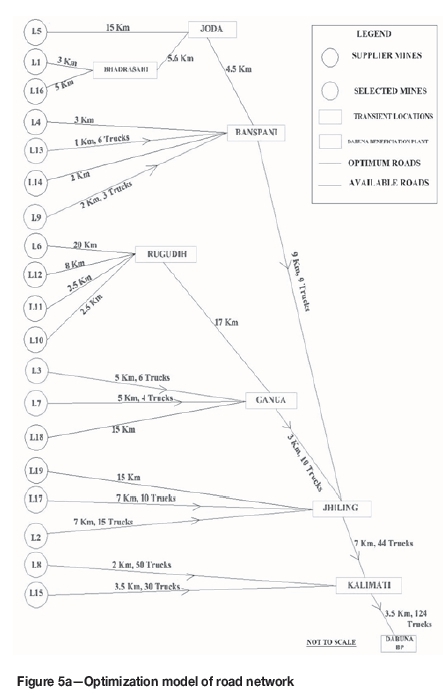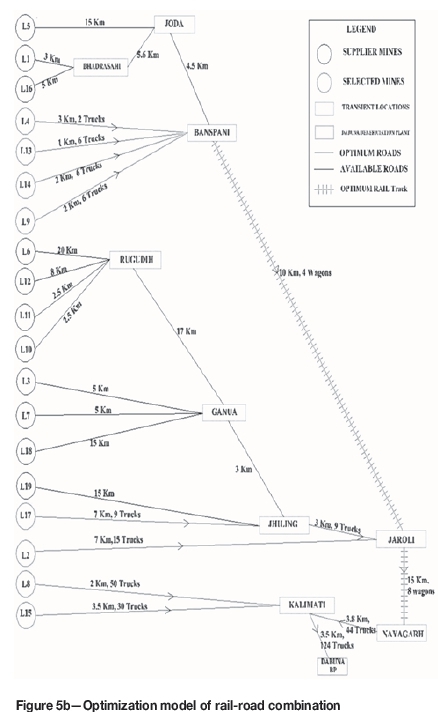Serviços Personalizados
Artigo
Indicadores
Links relacionados
-
 Citado por Google
Citado por Google -
 Similares em Google
Similares em Google
Compartilhar
Journal of the Southern African Institute of Mining and Metallurgy
versão On-line ISSN 2411-9717
versão impressa ISSN 2225-6253
J. S. Afr. Inst. Min. Metall. vol.117 no.4 Johannesburg Abr. 2017
http://dx.doi.org/10.17159/2411-9717/2017/v117n4a13
GENERAL PAPERS
A methodology for assessing the cumulative impact of a mineral transportation system on air quality
E. Kumar; L.A. Kumar
Department of Mining Engineering, CEG, Anna University Chennai, India
SYNOPSIS
A methodology is proposed to develop an optimization model to understand the impact of transporting minerals, from mines to the final destination, on air quality. Recently, there has been increasing concern about the combined effects of multiple activities over many years, and the regional environmental changes brought about by a single project. Environmental issues in the iron ore industry have highlighted the need to broaden the cumulative impact assessment. In this study, we simulated the optimal routes and quantity of materials needed to meet the destination plant demand based upon environment constraints (level of air pollution), as well as the cost of transportation and availability of materials. Multiple scenarios were developed to analyse the effects of changes in routes, alternative transport system (or multi-modal split), traffic congestion, and the cumulative impacts on air quality. The air quality impact zones of the study area were demarcated using a GIS technique. The expected outcome of the study is the selection of a suitable transport system for a particular site with the least impact on air quality, including the transportation route, relative to the minimum cost of transportation of the minerals from the mines to their final destination. The proposed methodology is evaluated with a case study.
Keywords: air quality, cumulative impacts, transportation system, GIS.
Introduction
In India, the process of environmental impact assessment (EIA) has been focused primarily on the local impacts of projects, without considering regional environmental effects. Environmental clearances for proposed projects are based on reports of local impacts. However, any developmental project poses a potential risk to the environment as a whole, and not just in the immediate vicinity of the project. Recently, there has been increased concern about the combined effects of multiple activities over many years-the regional environmental changes due to development of a single project (Dutta, Mahatha, and De, 2004). Environmental issues throughout the country, particularly in the iron ore industry, have emphasized the need to broaden the analysis to include the combined impacts, or those forecast for a proposed region, on an existing environment. The most significant adverse environmental consequences of iron ore transportation are the deterioration of biodiversity and air quality (Kumar and Ajay, 2015).
Kalidindi and Singh (2009) have projected that on a global basis, pollutant emissions from the transport sector would double by 2030. Analysis of cumulativeness in EIAs can help to predict the level of impact in qualitative terms and emission factors per unit of freight transported (Rodrigue, Comtois, and Slack, 2013). The environmental impact depends on the quantity of goods (emissions per unit freight), the distance they are transported, and the spatial pattern of goods transported, including the mode of transport. Airborne particulate matter can be a significant nuisance to local communities and a potential health hazard in certain circumstances. It is produced from a number of sources and through a number of mechanisms such as land clearing, removal of topsoil and overburden, drilling, blasting, crushing and screening, processing of ore, loading and unloading of material on site, and subsequent transport. In addition, wind action near stockpiles, dry tailings, exposed mining areas, and waste dumps also generates significant amounts of pollutants.
This paper presents a proposed methodology quantifying the cumulative impact on air quality caused by mineral transportation from various mines to a beneficiation plant, using geographical analysis, a programming model, an air dispersion model, and a system dynamic model.
Methodology
EIAs are accepted as a decision-making tool that takes into account the environmental, economic, and social consequences of development. To obtain environmental clearance, projects involving potentially polluting activities have to be subjected to environmental studies. However, the analyses that have been performed to date only consider the environmental impact of individual projects, and ignore the overall environment and the cumulative effects of various projects proposed for a given region. Although required by international and national environmental legislation, the concept of cumulative assessment has not been included in environmental impact assessment procedures (Cavalcanti and La Rovere, 2011).
Tools for cumulative impact assessment are being developed and applied (US EPA, 1999). The analysis of cumulative impacts involves identifying and assessing the incremental impact of a proposed project or combination of projects on the environment over a period of time. The level of assessment of the cumulative effects is limited because of the inability to measure all types of effects and map the impact zones, and the uncertainties surrounding future developments.
In the present study, the methodology outlined in Figure 1 was adopted to analyse the environmental impact of iron ore transportation from various mines in different locations to a central beneficiation plant. The study included identification of pollution sources, mapping of the impact area, selection of the optimum transportation system and routes, cumulative air quality impact analysis using a dispersion model, and forecasting of future traffic congestion using a system dynamic model.

Initially, the characteristics of the factors affecting the environment were studied. Air pollution by vehicular emission in India is exceeding threshold levels and deteriorating people's quality of life (Singh, 2006). Although some gaseous pollutants such as CO, NOx, and SO2 are also released by diesel-powered equipment and blasting operations, the contribution of such emissions to total pollution levels is minor.
The pollutant concentrations in terms of particulate matter (PM) near major industries, intersections, and roadways have exceeded the Indian national ambient air quality standards (Beig, Ghude, and Deshpande, 2010). PM has serious health effects, especially in the form of respiratory diseases.
The methodology followed in this study illustrates the importance of cumulative impact assessment of PM emissions during the transportation of iron ore. The zone of impact of the proposed transportation routes was also identified. The zone was digitized using combined topographical sheets and the satellite image was interpreted using GIS software to identify the affected road, rail, residential, and mining areas. This was followed by a baseline study of the region to collect meteorological data and its variations throughout the year. The data was used to set up the air monitoring stations along the transportation routes.
In the second stage of the investigation, a programming model was used to find the optimum solution that is feasible in particular site conditions based on the derived objective function. The model was also used to analyse the influencing parameter in any particular condition and to forecast consequences for the given variables and constraints. Among the various techniques, linear programming offers a potential planning approach to investigate and manage cumulative environmental problems (Smit and Spaling, 1995). The optimization model seeks to find values of the decision variables that optimize (maximize or minimize) an objective function among the set of all values for the decision variables that satisfy the given constraints. The identified road and rail segments for transportation of iron ore to the beneficiation plant were analysed for the volume of traffic to be handled. A scenario-based analysis was done for a suitable transportation system which could minimize the impacts on air quality.
An emission factor is a representative value that attempts to quantify the amount of pollutant released to the atmosphere due to a particular activity. For transportation, these factors are usually expressed as the weight of the pollutant emitted per unit travelling distance (vehicle-kilometres travelled). The determination of appropriate emission factor for a particular operation is imperative as it will help to obtain prior information on the likely impact on air quality (Chaulya et al., 2002). Once generated, the emission factor is used in conjunction with the vehicle kilometres travelled (VKT) to obtain the total emission due to transportation (Ghose, 2004; Roy, Adhikari, and Singh, 2010).
The emission factor for PM can be obtained by multiplying by a suitable factor that depends upon site conditions and the process. The following emissions factors (F) for various activities were considered for the optimization model:
► Vehicle exhaust (diesel-powered heavy-duty truck), F= 0.808 g/km (USEPA, 1985)
► Freight train emission (diesel locomotive), F = 1.30 g/l (Fritz, Swri, and Smith, 2007).
The calculation serves to delimit uncertainties in regional and global emission inventories and is necessary for modelling future changes.
A fundamental aspect of cumulative impact studies is the prospective view of the effects of actions intended to help in planning the mitigation measures during the preliminary stage of operation. Hence, air quality modelling and system dynamics were consolidated to analyse the level of cumulative impact of the proposed activities, evaluate the behaviour of the complex system, and forecast the future impacts over a span of time. The Industrial Source Complex Short Term Version 3 (ISCST3) model was chosen to simulate the dispersion of line source emission due to transportation activities in the study region. The baseline data was taken as input data for the dispersion model and processed in ISCST3. An integrated evaluation is required to identify and forecast the future impacts due to proposed and existing operations (Cavalcanti and La Rovere, 2011).
The System Dynamics (SD) model was adopted to forecast the future impacts due to interactions between development vectors in the region. With industrial development, environmental changes have become dynamic in nature. Many environmental engineers and researchers are framing environmental policies using SD procedures (Anand, Vrat, and Dahiya, 2006). In the present study, the model was run for a period of five years. The advantages and limitations of this new assessment method are presented in the discussion and conclusions sections of this paper.
Case study
To illustrate the proposed methodology for assessing the cumulative air quality impact of a mineral transportation system, a case study was conducted at Dabuna beneficiation plant located in Keonjhar district, Odisha. The plant is located in a high-quality iron ore belt containing a cluster of mines, and the area is well connected to major roads and rail transport. There is high potential for particulate emissions, mainly from drilling, loading, hauling, transportation, and exposed overburden dumps or tailings. The details of mines and the contracted quantity of iron ore for beneficiation at the plant are given in Table I.

The locations of the beneficiation plant, mines, and existing rail and road networks are shown in Figure 2. The economy of Keonjhar depends primarily on mining and transportation of iron ore to the local plants and ports for export. The annual requirement of iron ore for the proposed plant is 11 Mt/a. Implementation of proposed transportation activities may increase the regional environmental changes around the plant and mines, which necessitates the study of the cumulative impact of the transportation system for the proposed plant. The paper discusses only a representative study to demonstrate the developed methodology, and does not constitute a full-scale impact assessment for the actual project.
Geographical setting
The site of the proposed beneficiation plant is surrounded by hilly terrain. The 19 mines are scattered within a radius of approximately 25 km of the plant. There are several roads connecting various mines to the nearby major roads, and the vicinity of the proposed plant is connected by National Highway (NH) 215 and the Keonjhar Industrial Development Corporation (KIDCO) road. These two major roads are in turn connected to four railway sidings (Joda, Banspani, Jaroli, and Naragarh) on the major rail corridors in Keonjhar region. In these circumstances, road and rail-road combination were considered the most suitable means of transporting iron ore from multi-location mines to the plant. A ropeway or conveyor system would require a huge area of land. However, the proposed land category is non-transferable and the acquisition of such a large land area would need several regulatory clearances. For these reasons, the use of ropeways and conveyors as a mode of transportation was not considered feasible in the current circumstances.
The impact zones were delineated using the buffering capability of GIS software as shown in Figure 3. As seen from the digitized map, five concentric zones were buffered in increments of 5 km radius, to include all 19 mines the surrounding villages, and existing roads and railways. It is pertinent to state here that the study considered all the transportation routes falling within the composite core zones and buffer zones of the plant. Furthermore, the transportation routes were divided into six segments, which are typical of the maximum transport load distribution for the area as far as the mining and railway sidings are concerned.
Baseline study
The baseline data studied for the Dabuna area included the detailed characterization of various environmental parameters. The possible effects of the proposed beneficiation project were estimated and superimposed on the compiled baseline data to assess the cumulative effects. The baseline data for the existing ambient air quality within the composite core and buffer zones of the proposed beneficiation plant was assessed through a network of eight ambient air quality monitoring (AQM) stations, which were located based on the predominant wind direction and wind speed in the study area. The AQM stations were monitored on a 24-hourly basis and twice a week at each location as per the Central Pollution Control Board (CPCB 2009) guidelines for the pre-monsoon season. The ambient air quality was measured for PM concentration along the transportation routes. Meteorological data is very useful for the interpretation of baseline information and modelling of air quality impacts, and helps understanding of the dispersion of pollutants. The principal wind direction at the project site is from the southwest, followed by the southeast. The average wind speed is shown in Figure 4. The maximum temperature recorded was 40.3°C and the minimum 12°C. The maximum relative humidity recorded during the pre-monsoon season was 87.2%.
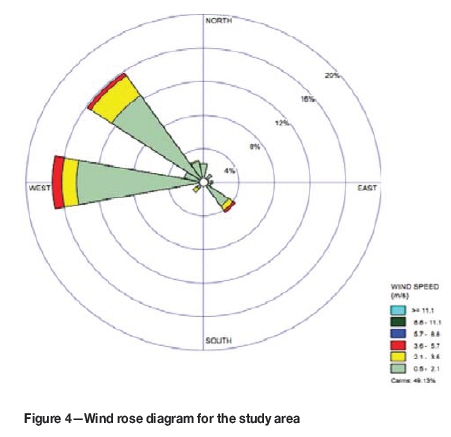
Programming model
Iron ore was transported from the 19 mines for various distances to the Dabuna beneficiation plant by road and rail. The determination of the increment level of PM from the transportation system will help environmental engineers and beneficiation plant managers obtain actual information about its likely impacts on the surrounding air quality. Based on the prediction of increments of air pollutant concentrations, the optimum mode of transport and most effective routes can be determined.
The transportation problem was formulated using the linear programming model with LINGO software (Figure 5). The optimization model consisted of three primary sections:
► Objective function-minimize the emission level and cost of transportation (road and rail-road combination)
► Variables-the parameters that influence the optimal value of the objective function are the number of trucks/wagons, number of mines, maximum and minimum quantities of iron ore required per hour, and number of routes
► Constraints-these define the limits on the values of the variables; demand of beneficiation plant > 1527.6 t/h, distance to be travelled, number of trucks/wagons required per hour, capacity of trucks and wagons, freight charges by road and rail.
The model (Kumar and Ajay Kumar, 2015) for road and rail-road combination was adopted to optimize the emission rate from transportation routes and cost of transportation
The routes to be followed for transportation of iron ore from the different mines to the Dabuna beneficiation plant are connected by the NH-215, the KIDCO road, and village roads. It was essential to study the air quality impact of transportation of iron ore by various segments of existing roadways since the segments carry totally different traffic patterns. It was therefore decided to study the air impact analysis on the optimized routes under two conditions:
► proposed level of emissions due to transportation of iron ore for the beneficiation plant only, and
► cumulative effects from all activities around the study area.
Air quality modelling
The intensity and dispersion of particulate matter along the transportation routes were predicted using the ISCST3 model (Figure 6). The equation considered for the modelling is based on the straight-line steady-state of Gaussian plume dispersion, developed and recommended by the US EPA.
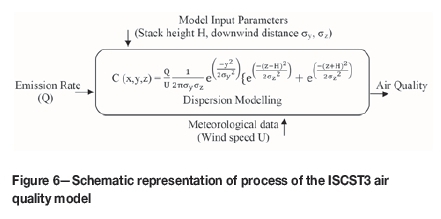
The emission factor of the US EPA was used for the calculation of emission rates in the model. The line source model was run for each transport segment from the mines to the destination plant, taking into consideration the fact that the potential transportation corridor will also be utilized for other activities. The incremental pollution load due to proposed transportation activities was estimated segment-wise for the road and road-rail combination, and the combined impacts in the study area are tabulated in Tables II and III. The impact modelling was used to resolve the complicated quantitative analysis of regional impacts.
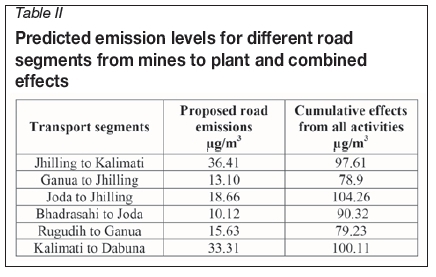
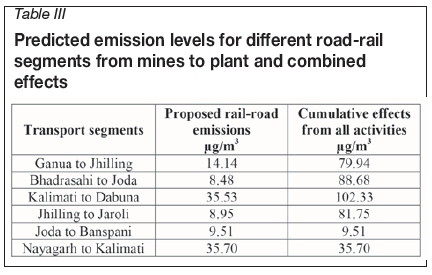
From the tables, it may be seen that the transport of iron ore makes only a minor contribution to the overall air quality impact. When the cumulative effect of all activities is considered, the predicted emission level for the transportation segments is more than the threshold value. Hence, the study highlights the importance of cumulative impact assessment for any development project.
The identified road segments for the transportation of iron ore were analysed for the volume of traffic handled, carrying capacity of the road, as well as the level of service of the road, in order to arrive the traffic congestion in the region due to the proposed plant.
System dynamics
The system dynamics (SD) methodology is a framework for modelling and simulating the dynamic behaviour of nonlinear systems and the manner in which information, action, and consequences interact. The simulation can be used with different parameters to investigate different scenarios over a period of time.
In the present case, the SD approach was used to forecast the current and future traffic impacts along transportation segments. From the optimization model, it was observed that in both the options of road and rail-road combination, 124 loaded trucks per hour were proposed to operate for transportation of iron ore. A major challenge of the Keonjhar district is movement of raw materials by trucks. Hence, the model was applied to make projections of traffic congestion on roadways in terms of volume to capacity (V/C) ratio in the Dabuna region for a time span of 5 years. A causal loop diagram, shown in Figure 7, was developed by incorporating various parameters such as induced traffic from the proposed plant, existing traffic volume in the study area, and capacity of road segments.
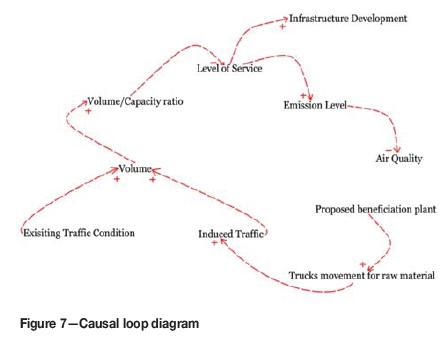
A flow diagram was then created and dynamo equations for each parameter in the diagram were added in the model (Figure 8).The dynamo equation [1] used to account for traffic density is (Ponnurangam and Umadevi, 2015):

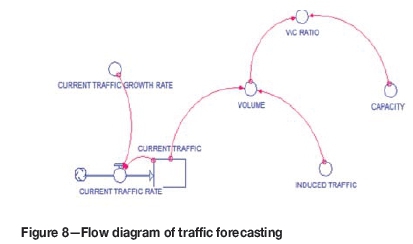
where
Capacity = 7 051 800 (number of vehicles per unit time) Volume = current_traffic plus induced_traffic Induced_traffic = 1 086 240 (number of vehicles per unit time)
Current_traffic = 5 083 720 (number of vehicles per unit time)
Current_traffic (t) = Current_Traffic(t - dt) +
(Current_traffic_rate)* dt
Inflows:
Current_traffic_rate =
Current_traffic_growth_rate*Current_traffic
Current_traffic_growth_rate = 3/100
Data for existing traffic and growth rate was calibrated from the official figure (PCD, 2015). The cumulative traffic impact in terms of V/C ratio due to proposed transportation activities for the plant and existing development activities was 0.87 for the current year, and from the historical trend this is projected to increase to 0.99 after 5 years.
From the above model (Figure 9), it can be seen that the service level of the roads is poor as per the Indian Roads Congress (IRC) standard. It is concluded that any proposed development activities may impact the regional traffic congestion adversely. Hence, it is recommended that the existing infrastructure should be improved before any proposed projects are implemented in the study area.
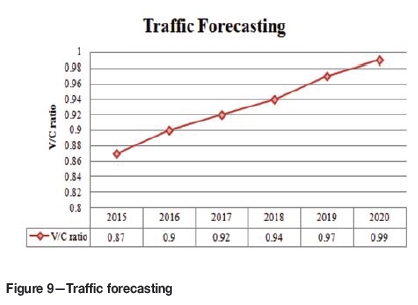
Discussion
The present study aimed to quantify pollutant concentration on transportation routes from mines to the proposed plant, to assess the air quality impact due to the transport of iron ore by road and rail-road combination, and optimize the transportation routes to the plant. Road and rail capacity were also optimized for traffic and emission load in order to find the best suitable system and routes to transport 11 Mt/a of iron ore to the plant. An impact analysis was done for road transportation and a rail-road combination, keeping in mind the impact on regional air quality. The practical significance of the developed methodology is that it is based on actual site studies and not on theoretical assumptions. The proposed traffic conditions around the beneficiation plant will have minimal impact with regular water sprinkling, which will also improve road conditions with least baseline concentration and further reduce line source emission levels.
Conclusions
The present study yielded the ultimate objective of the proposed methodology; that is, to quantify the cumulative impact of air quality of a mineral transportation system from various mines to the destination plant. The ISCST3 model was used to analyse the emission level from proposed activities through road and railroad combination scenarios, and the combined emission effects of all other activities were also considered. The result from the model could help in choosing either existing transportation segments or new transport networks.
The study proposes a new avenue for research in the area of application of cumulative impact assessment for mining-related projects using various scientific models. The proposed methodology, the models discussed, and the results may be utilized to visualize future environmental scenarios in the Keonjhar region and aid in decision-making at the regional level in terms of permission for transportation of iron ore. Although the approaches carried out for the proposed mineral transportation system of beneficiation plant were adequate for the purposes of this study, a huge amount of data would be required to complete a comprehensive cumulative impact assessment.
Acknowledgement
The authors thank the management of the iron ore mines and beneficiation plant in Keonjhar region, Odisha for their cooperation and for providing the necessary facilities during the field study. We also thank the Department of Mining Engineering, College of Engineering Guindy, Anna University for providing technical supports and facilities.
References
Anand, S., Vrat, P., and Dahiya, R.P. 2006. Application of a system dynamics approach for assessment and mitigation of CO2 emissions from the cement industry. Journal of Environmental Management, vol.79. pp. 383-398. [ Links ]
Beig, G., Ghude, S.D., and Deshpande, A. 2010. Scientific evaluation of air quality standards and defining air quality index for India. Research Report no. RR-127. Ministry of Earth Sciences, Government of India. [ Links ]
Cavalcanti, P.M.P.S. and La Rovere, E.L. 2011. Strategic environmental assessment of mining activities: a methodology for quantification of cumulative impacts on the air quality. Journal of the Air & Waste Management Association, vol. 61, no. 4. pp. 377-389. [ Links ]
Chaulya, S.K., Chakraborty, M.K., Ahmad, M., Singh, R.S., Bondyopadhay, C., Mondal, G. C., and Pal, D. 2002. Development of empirical formulae to determine emission rate from various opencast coal mining operations. Water, Air, and Soil Pollution, vol. 140, no. 1-4. pp. 21-55. [ Links ]
CPCB (Central Pollution Control Board). 2009. National Ambient Air Quality Standards. Government of India. [ Links ]
Dutta, P., Mahatha, S., and De, P. 2004. A methodology for cumulative impact assessment of opencast mining projects with special reference to air quality assessment. Impact Assessment and Project Appraisal, vol. 22, no.3. pp. 235-250. [ Links ]
Fritz, S., Swri, and Smith, B. 2007. Locomotive emissions testing 2006 summary report for emissions testing of in-use locomotives conducted by the North American Class 1 railroads to the Environmental Protection Agency federal test. Procedure LA-023. Transportation Technology Centre, Pueblo, Colorado. [ Links ]
Ghose, M.K. 2004. Emission factors for the quantification of dust in Indian coal mines. Journal of Scientific and Industrial Research, vol. 63, pp. 763-768. [ Links ]
Kalidindi, S.N. and Singh, L.B. 2009. Financing road projects in India using PPP scheme. Proceedings of the 2009 Mid-Continent Transportation Research Symposium, Ames, Iowa, August 2009. Institute for Transportation, Iowa State University. pp. 1-13. [ Links ]
Kumar, K.K. 2008. Logistics of iron ore transportation. Seminar: Chartered Institute of Logistics and Transportation London, New Delhi. pp. 1-44. [ Links ]
Kumar, E., and Ajay Kumar, L. 2015. Optimization of pollution load due to iron ore transportation - A case study. Proceedings of Global Challenges, Policy Framework and Sustainable Development/or Mining of Mineral and Fossil Energy Resources (GCPF2015), 17-18 April 2015. Procedia Earth and Planetary Science, vol. 11. pp. 232-239. [ Links ]
PCD (Planning and Coordination Department). 2015. Odisha Economic Survey 2014-15. Directorate of Economics and Statistics, Government of Odisha. [ Links ]
Ponnurangam, P. and Umadevi, G. 2015. Sustainable transportation planning a systems approach. International Journal of Civil Engineering and Technology (IJCIET), vol. 6, no. 6. pp. 187-195. [ Links ]
Rodrigue, J.P., Comtois, C., and Slack, B. 2013. The Geography of Transport Systems. Routledge, New York. [ Links ]
Roy, S., Adhikari, G.R., and Singh, T.N. 2010. Development of emission factors for quantification of blasting dust at surface coal mines. Journal of Environmental Protection, vol. 1. pp. 346-361. [ Links ]
Singh, S.K. 2006. Future mobility in India: Implications for energy demand and Co2 emission. Transport Policy, vol. 13, no. 5. pp. 398-412. [ Links ]
Smit, B., and Spaling, H. 1995. Methods for cumulative effects assessment. Environmental Impact Assessment Review, vol. 15, no. 1. pp. 81-106. [ Links ]
US EPA (U S Environmental Protection Agency). 1985. Compilation of air pollutant emission factors. AP-42. Office of Air and Radiation Office of Quality Planning and Standards, Research Triangle Park, North Carolina. [ Links ]
US EPA (US Environmental Protection Agency). 1999. Consideration of cumulative impacts in EPA review of NEPA documents. Office of Federal Activities (2252A), EPA 315-R-99-002. [ Links ]
Paper received Oct. 2015
Revised paper received Jan. 2017.













